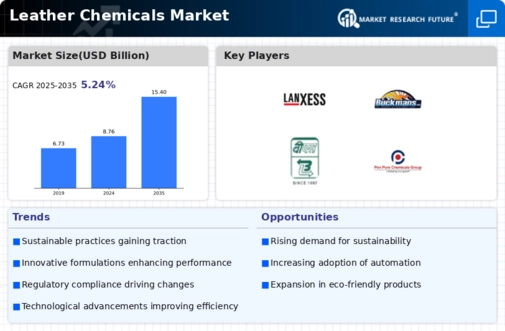Market Analysis
In-depth Analysis of Leather Chemicals Market Industry Landscape
The leather chemicals market is influenced by several factors that shape its dynamics. Understanding these dynamics is crucial for stakeholders to make informed decisions and navigate this competitive landscape effectively.
Growing Demand: The demand for leather chemicals is steadily increasing due to the rising consumption of leather in various industries such as automotive, fashion, and furniture. This demand is primarily driven by factors like population growth, urbanization, and changing consumer preferences for leather products.
Technological Advancements: Technological advancements in leather processing have led to the development of innovative chemicals that enhance the quality and properties of leather. Manufacturers are investing in research and development to introduce eco-friendly chemicals that comply with stringent environmental regulations.
Globalization: The leather chemicals market is heavily influenced by globalization trends. International trade agreements and partnerships facilitate the exchange of raw materials and finished products, impacting market dynamics. Fluctuations in currency exchange rates and trade policies also play a significant role in shaping market trends.
Environmental Regulations: Stringent environmental regulations regarding the use of chemicals in leather processing have prompted manufacturers to adopt sustainable practices. This has led to a shift towards eco-friendly chemicals and processes, driving innovation in the market.
Price Volatility: The leather chemicals market is susceptible to price volatility due to fluctuations in raw material prices, energy costs, and geopolitical factors. Manufacturers and stakeholders need to closely monitor these factors and implement strategies to mitigate risks associated with price fluctuations.
Consumer Awareness: Growing consumer awareness regarding the environmental impact of leather production has influenced market dynamics. Consumers are increasingly demanding leather products that are produced using eco-friendly processes and chemicals, prompting manufacturers to adapt their offerings accordingly.
Competitive Landscape: The leather chemicals market is highly competitive, with numerous players competing based on factors such as product quality, price, and innovation. Market consolidation through mergers and acquisitions is common, as companies seek to strengthen their market position and expand their product portfolios.
Regional Trends: Market dynamics vary across different regions, influenced by factors such as economic development, consumer preferences, and regulatory frameworks. Emerging economies are witnessing rapid growth in the leather chemicals market, driven by industrialization and increasing disposable income levels.
Supply Chain Management: Effective supply chain management is crucial for maintaining a competitive edge in the leather chemicals market. Timely procurement of raw materials, efficient production processes, and strategic distribution networks are essential for meeting market demand and maximizing profitability.
Consumer Preferences: Changing consumer preferences for sustainable and ethically sourced leather products are reshaping market dynamics. Manufacturers are increasingly focusing on transparency and traceability in their supply chains to meet consumer expectations and differentiate their products in the market.








Leave a Comment